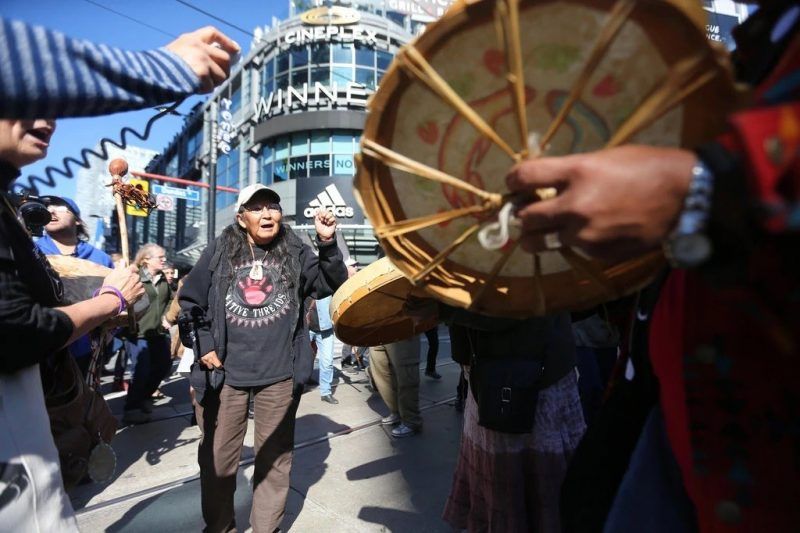
Billy Gauthier, an Inuk artist who lives in Labrador on Canada’s remote northeastern coast, began his hunger strike on Oct. 13 after a plate of salmon. The meal was highly symbolic.
The Nunatsiavut government in Labrador had released a study from a Harvard mercury researcher on the effects of the newly constructed Muskrat Falls dam. The study showed that water flooding the reservoir behind the dam would contain methylmercury levels “to the point that they exceed regulatory thresholds for exposure,” building up over time in fish and other game consumed by the native population.
And so Mr. Gauthier refused to eat the fish that the Muskrat Falls project would contaminate. Thirteen days later, the provincial government promised to act on an independent assessment of the health risks to the people of Labrador, and Mr. Gauthier celebrated with a plate of arctic char.
He may have celebrated too soon. Already the government’s commitment is looking doubtful, with Stan Marshall, the chief executive of Nalcor Energy, the company responsible for the dam, publicly playing down the methylmercury risks.
Muskrat Falls has brought up urgent questions for the country as a whole at a turning point in our relationship to First Peoples: How serious are we about the process of truth and reconciliation?
Muskrat Falls will affect three peoples — the Innu, the Nunatsiavut and the NunatuKavut — who will have to alter their diets, and as such their cultures. Methylmercury has a particularly strong effect on women and children and can lead to intellectual impairments and immune system problems. Some of the hydroelectric dams have already disrupted the hunting and fishing traditions of the Cree living nearby.
Justin Trudeau, who wears a shoulder tattoo based on the print “Raven Bringing Light to the World” by the Haida artist Robert Davidson, made truth and reconciliation with Canada’s First Nations a priority of his election platform.
Since Mr. Trudeau’s election a year ago, changes grand and subtle have been made. At Toronto schools, morning announcements begin with recognizing the original settlers of the land. “I would like to acknowledge that this school is situated upon traditional territories,” it begins, before establishing which peoples the territories belonged to (in Toronto’s case, the Mississaugas of the New Credit), and concluding, “I also recognize the enduring presence of aboriginal peoples on this land.”
Other changes have been more material. In his cabinet, Mr. Trudeau appointed the first indigenous minister of justice in the country’s history, Jody Wilson-Raybould, a woman who had served previously as regional chief of the British Columbia Assembly of First Nations.

This past summer, the Trudeau government announced a national inquiry into the continuing crisis of murdered and missing aboriginal women. The first Liberal budget added $8.4 billion over five years for indigenous community infrastructure, in order to bring “transformational change” in reserves across the country.
But in the middle of the well-intentioned festivities, the crisis in Muskrat Falls arrived like a bloody ghost, summoning up the very worst of Canadian history. Muskrat Falls echoes what the Canadian historian James Daschuk has called “the politics of starvation.” In his 2013 study, “Clearing the Plains,” Mr. Daschuk argued that famine was a conscious settlement strategy to “create ecological conditions in which disease exploded.”
In a famous anecdote, Justin Trudeau’s father, Prime Minister Pierre Trudeau, made the same point in a meeting with Marlon Brando when the American actor wanted to discuss native rights.
“There are differences in the way we treated our natives,” he said. “You hunted them down and murdered them. We starved them to death.”
A flip remark, but one based in history. Recent historical research has uncovered evidence that federal government officials, in remote communities in northern Manitoba in the 1940s, used malnourished indigenous peoples to test theories of vitamins. In 1947, they tested on 1,000 hungry children in half a dozen residential schools, deliberately withholding milk rations to get a “baseline reading” of the effects of malnutrition.
Nutritional questions have always been cultural questions for the indigenous peoples of Canada. Hunting and fishing are more than a traditional way of life. The land is the connection to the larger world and to history. High methylmercury levels would render the land untrustworthy. If you cannot trust the land, what can you trust?
When the Harvard study of Muskrat Falls was released, Nalcor initially proposed simply putting up advisory warnings to limit the consumption of fish. The company had resisted the obvious, expensive solution — clearcutting the land for the dam’s reservoir and stripping the topsoil before flooding, which removes the buildup of methylmercury in organic matter.
“I’d like to say I was surprised, but I wasn’t surprised,” Mr. Gauthier declared, renewing his promise to resume the hunger strike if Nalcor failed to live up to its commitments.
Will Canada live up to its commitments? Mr. Trudeau represents a new generation in Canadian politics, literally and figuratively. He has brought in a new, much younger, team to Ottawa. That generation, like President Obama’s eight years ago, came to power with the idea they were better than those who went before.
Now they are facing the oldest confrontation in Canadian history: the power of economic motives against indigenous claims to the land with the federal government in between as, at best, a dubious intermediary. Well-meaning phrases at the school announcements will not suffice. How can you atone for a crime while you’re still in the middle of committing it?
Stephen Marche, a contributing editor for Esquire magazine, is the author of the novel The Hunger of the Wolf.
